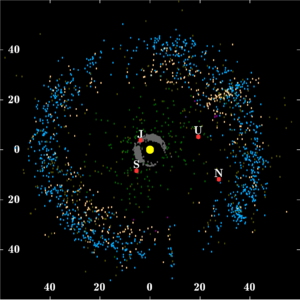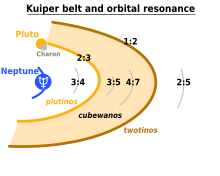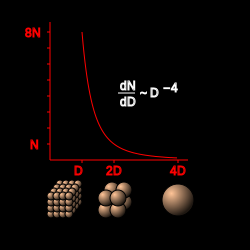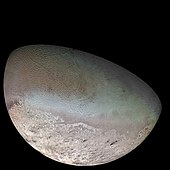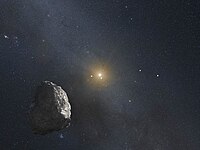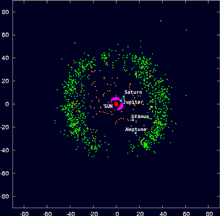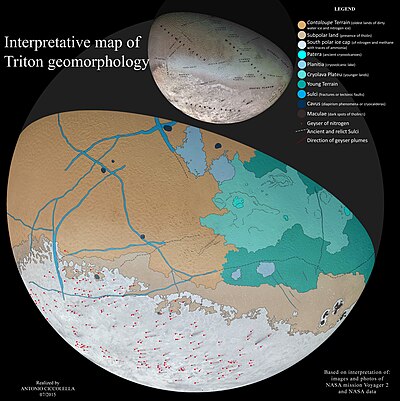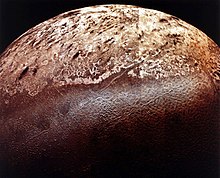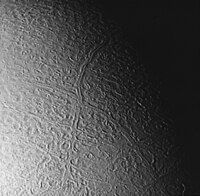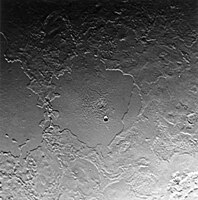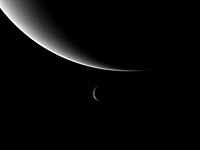Known objects in the Kuiper belt beyond the orbit of Neptune. (Scale in AU; epoch as of January 2015.)
| Sun Jupiter trojans Giant planets: J · S · U · N Centaurs | Kuiper belt Scattered disc Neptune trojans |
Distances but not sizes are to scale
Source: Minor Planet Center, www
Source: Minor Planet Center, www
The Kuiper belt (/ˈkaɪpər/), occasionally called the Edgeworth–Kuiper belt, is a circumstellar disc in the outer Solar System, extending from the orbit of Neptune (at 30 AU) to approximately 50 AU from the Sun. It is similar to the asteroid belt, but is far larger—20 times as wide and 20 to 200 times as massive. Like the asteroid belt, it consists mainly of small bodies or remnants from when the Solar System formed. While many asteroids are composed primarily of rock and metal, most Kuiper belt objects are composed largely of frozen volatiles (termed "ices"), such as methane, ammonia and water. The Kuiper belt is home to three officially recognized dwarf planets: Pluto, Haumea and Makemake. Some of the Solar System's moons, such as Neptune's Triton and Saturn's Phoebe, may have originated in the region.
The Kuiper belt was named after Dutch-American astronomer Gerard Kuiper, though he did not predict its existence. In 1992, Albion was discovered, the first Kuiper belt object (KBO) since Pluto and Charon.
Since its discovery, the number of known KBOs has increased to over a
thousand, and more than 100,000 KBOs over 100 km (62 mi) in diameter are
thought to exist. The Kuiper belt was initially thought to be the main repository for periodic comets,
those with orbits lasting less than 200 years. Studies since the
mid-1990s have shown that the belt is dynamically stable and that
comets' true place of origin is the scattered disc, a dynamically active zone created by the outward motion of Neptune 4.5 billion years ago; scattered disc objects such as Eris have extremely eccentric orbits that take them as far as 100 AU from the Sun.
The Kuiper belt is distinct from the theoretical Oort cloud,
which is a thousand times more distant and is mostly spherical. The
objects within the Kuiper belt, together with the members of the
scattered disc and any potential Hills cloud or Oort cloud objects, are collectively referred to as trans-Neptunian objects (TNOs).
Pluto is the largest and most massive member of the Kuiper belt, and
the largest and the second-most-massive known TNO, surpassed only by
Eris in the scattered disc.
Originally considered a planet, Pluto's status as part of the Kuiper
belt caused it to be reclassified as a dwarf planet in 2006. It is
compositionally similar to many other objects of the Kuiper belt and its
orbital period is characteristic of a class of KBOs, known as "plutinos", that share the same 2:3 resonance with Neptune.
History
After the discovery of Pluto
in 1930, many speculated that it might not be alone. The region now
called the Kuiper belt was hypothesized in various forms for decades. It
was only in 1992 that the first direct evidence for its existence was
found. The number and variety of prior speculations on the nature of the
Kuiper belt have led to continued uncertainty as to who deserves credit
for first proposing it.
Hypotheses
The first astronomer to suggest the existence of a trans-Neptunian population was Frederick C. Leonard. Soon after Pluto's discovery by Clyde Tombaugh in 1930, Leonard pondered whether it was "not likely that in Pluto there has come to light the first of a series
of ultra-Neptunian bodies, the remaining members of which still await
discovery but which are destined eventually to be detected". That same year, astronomer Armin O. Leuschner suggested that Pluto "may be one of many long-period planetary objects yet to be discovered."
Astronomer Gerard Kuiper, after whom the Kuiper belt is named
In 1943, in the Journal of the British Astronomical Association, Kenneth Edgeworth hypothesized that, in the region beyond Neptune, the material within the primordial solar nebula
was too widely spaced to condense into planets, and so rather condensed
into a myriad of smaller bodies. From this he concluded that "the outer
region of the solar system, beyond the orbits of the planets, is
occupied by a very large number of comparatively small bodies"
and that, from time to time, one of their number "wanders from its own
sphere and appears as an occasional visitor to the inner solar system", becoming a comet.
In 1951, in a paper in Astrophysics: A Topical Symposium, Gerard Kuiper
speculated on a similar disc having formed early in the Solar System's
evolution, but he did not think that such a belt still existed today.
Kuiper was operating on the assumption, common in his time, that Pluto was the size of Earth and had therefore scattered these bodies out toward the Oort cloud or out of the Solar System. Were Kuiper's hypothesis correct, there would not be a Kuiper belt today.
The hypothesis took many other forms in the following decades. In 1962, physicist Al G.W. Cameron postulated the existence of "a tremendous mass of small material on the outskirts of the solar system". In 1964, Fred Whipple, who popularised the famous "dirty snowball"
hypothesis for cometary structure, thought that a "comet belt" might be
massive enough to cause the purported discrepancies in the orbit of Uranus that had sparked the search for Planet X, or, at the very least, massive enough to affect the orbits of known comets. Observation ruled out this hypothesis.
In 1977, Charles Kowal discovered 2060 Chiron, an icy planetoid with an orbit between Saturn and Uranus. He used a blink comparator, the same device that had allowed Clyde Tombaugh to discover Pluto nearly 50 years before. In 1992, another object, 5145 Pholus, was discovered in a similar orbit. Today, an entire population of comet-like bodies, called the centaurs,
is known to exist in the region between Jupiter and Neptune. The
centaurs' orbits are unstable and have dynamical lifetimes of a few
million years.
From the time of Chiron's discovery in 1977, astronomers have
speculated that the centaurs therefore must be frequently replenished by
some outer reservoir.
Further evidence for the existence of the Kuiper belt later
emerged from the study of comets. That comets have finite lifespans has
been known for some time. As they approach the Sun, its heat causes
their volatile
surfaces to sublimate into space, gradually dispersing them. In order
for comets to continue to be visible over the age of the Solar System,
they must be replenished frequently.
One such area of replenishment is the Oort cloud, a spherical swarm of
comets extending beyond 50,000 AU from the Sun first hypothesised by
Dutch astronomer Jan Oort in 1950. The Oort cloud is thought to be the point of origin of long-period comets, which are those, like Hale–Bopp, with orbits lasting thousands of years.
There is another comet population, known as short-period or periodic comets, consisting of those comets that, like Halley's Comet, have orbital periods
of less than 200 years. By the 1970s, the rate at which short-period
comets were being discovered was becoming increasingly inconsistent with
their having emerged solely from the Oort cloud. For an Oort cloud object to become a short-period comet, it would first have to be captured by the giant planets. In a paper published in Monthly Notices of the Royal Astronomical Society in 1980, Uruguayan astronomer Julio Fernández
stated that for every short-period comet to be sent into the inner
Solar System from the Oort cloud, 600 would have to be ejected into interstellar space. He speculated that a comet belt from between 35 and 50 AU would be required to account for the observed number of comets. Following up on Fernández's work, in 1988 the Canadian team of Martin Duncan, Tom Quinn and Scott Tremaine
ran a number of computer simulations to determine if all observed
comets could have arrived from the Oort cloud. They found that the Oort
cloud could not account for all short-period comets, particularly as
short-period comets are clustered near the plane of the Solar System,
whereas Oort-cloud comets tend to arrive from any point in the sky. With
a "belt", as Fernández described it, added to the formulations, the
simulations matched observations.
Reportedly because the words "Kuiper" and "comet belt" appeared in the
opening sentence of Fernández's paper, Tremaine named this hypothetical
region the "Kuiper belt".
Discovery
The array of telescopes atop Mauna Kea, with which the Kuiper belt was discovered
In 1987, astronomer David Jewitt, then at MIT, became increasingly puzzled by "the apparent emptiness of the outer Solar System". He encouraged then-graduate student Jane Luu to aid him in his endeavour to locate another object beyond Pluto's orbit, because, as he told her, "If we don't, nobody will." Using telescopes at the Kitt Peak National Observatory in Arizona and the Cerro Tololo Inter-American Observatory in Chile, Jewitt and Luu conducted their search in much the same way as Clyde Tombaugh and Charles Kowal had, with a blink comparator. Initially, examination of each pair of plates took about eight hours, but the process was sped up with the arrival of electronic charge-coupled devices
or CCDs, which, though their field of view was narrower, were not only
more efficient at collecting light (they retained 90% of the light that
hit them, rather than the 10% achieved by photographs) but allowed the
blinking process to be done virtually, on a computer screen. Today, CCDs
form the basis for most astronomical detectors. In 1988, Jewitt moved to the Institute of Astronomy at the University of Hawaii. Luu later joined him to work at the University of Hawaii's 2.24 m telescope at Mauna Kea.
Eventually, the field of view for CCDs had increased to 1024 by 1024
pixels, which allowed searches to be conducted far more rapidly.
Finally, after five years of searching, Jewitt and Luu announced on
August 30, 1992 the "Discovery of the candidate Kuiper belt object" 15760 Albion. Six months later, they discovered a second object in the region, (181708) 1993 FW.
Studies conducted since the trans-Neptunian region was first
charted have shown that the region now called the Kuiper belt is not the
point of origin of short-period comets, but that they instead derive
from a linked population called the scattered disc. The scattered disc was created when Neptune migrated outward
into the proto-Kuiper belt, which at the time was much closer to the
Sun, and left in its wake a population of dynamically stable objects
that could never be affected by its orbit (the Kuiper belt proper), and a
population whose perihelia
are close enough that Neptune can still disturb them as it travels
around the Sun (the scattered disc). Because the scattered disc is
dynamically active and the Kuiper belt relatively dynamically stable,
the scattered disc is now seen as the most likely point of origin for
periodic comets.
Name
Astronomers
sometimes use the alternative name Edgeworth–Kuiper belt to credit
Edgeworth, and KBOs are occasionally referred to as EKOs. Brian G. Marsden
claims that neither deserves true credit: "Neither Edgeworth nor Kuiper
wrote about anything remotely like what we are now seeing, but Fred Whipple did". David Jewitt comments: "If anything... Fernández most nearly deserves the credit for predicting the Kuiper Belt."
KBOs are sometimes called "kuiperoids", a name suggested by Clyde Tombaugh. The term "trans-Neptunian object"
(TNO) is recommended for objects in the belt by several scientific
groups because the term is less controversial than all others—it is not
an exact synonym though, as TNOs include all objects orbiting the Sun past the orbit of Neptune, not just those in the Kuiper belt.
Structure
At its fullest extent (but excluding the scattered disc), including
its outlying regions, the Kuiper belt stretches from roughly 30 to 55
AU. The main body of the belt is generally accepted to extend from the
2:3 mean-motion resonance at 39.5 AU to the 1:2 resonance at roughly 48 AU. The Kuiper belt is quite thick, with the main concentration extending as much as ten degrees outside the ecliptic plane and a more diffuse distribution of objects extending several times farther. Overall it more resembles a torus or doughnut than a belt. Its mean position is inclined to the ecliptic by 1.86 degrees.
The presence of Neptune has a profound effect on the Kuiper belt's structure due to orbital resonances.
Over a timescale comparable to the age of the Solar System, Neptune's
gravity destabilises the orbits of any objects that happen to lie in
certain regions, and either sends them into the inner Solar System or
out into the scattered disc or interstellar space. This causes the Kuiper belt to have pronounced gaps in its current layout, similar to the Kirkwood gaps in the asteroid belt.
In the region between 40 and 42 AU, for instance, no objects can retain
a stable orbit over such times, and any observed in that region must
have migrated there relatively recently.
The various dynamical classes of trans-Neptunian objects.
Classical belt
Between the 2:3 and 1:2 resonances with Neptune, at approximately
42–48 AU, the gravitational interactions with Neptune occur over an
extended timescale, and objects can exist with their orbits essentially
unaltered. This region is known as the classical Kuiper belt, and its members comprise roughly two thirds of KBOs observed to date. Because the first modern KBO discovered (Albion, but long called (15760) 1992 QB1), is considered the prototype of this group, classical KBOs are often referred to as cubewanos ("Q-B-1-os"). The guidelines established by the IAU demand that classical KBOs be given names of mythological beings associated with creation.
The classical Kuiper belt appears to be a composite of two
separate populations. The first, known as the "dynamically cold"
population, has orbits much like the planets; nearly circular, with an orbital eccentricity
of less than 0.1, and with relatively low inclinations up to about 10°
(they lie close to the plane of the Solar System rather than at an
angle). The cold population also contain a concentration of objects,
referred to as the kernel, with semi-major axes at 44–44.5 AU.
The second, the "dynamically hot" population, has orbits much more
inclined to the ecliptic, by up to 30°. The two populations have been
named this way not because of any major difference in temperature, but
from analogy to particles in a gas, which increase their relative
velocity as they become heated up. Not only are the two populations in different orbits, the cold population also differs in color and albedo, being redder and brighter, has a larger fraction of binary objects, has a different size distribution, and lacks very large objects.
The difference in colors may be a reflection of different compositions,
which suggests they formed in different regions. The hot population is
proposed to have formed near Neptune's original orbit and to have been
scattered out during the migration of the giant planets.
The cold population, on the other hand, has been proposed to have
formed more or less in its current position because the loose binaries
would be unlikely to survive encounters with Neptune.
Although the Nice model appears to be able to at least partially
explain a compositional difference, it has also been suggested the color
difference may reflect differences in surface evolution.
Resonances
Distribution of cubewanos (blue), Resonant trans-Neptunian objects (red), Sednoids (yellow) and scattered objects (grey)
Orbit classification (schematic of semi-major axes)
When an object's orbital period is an exact ratio of Neptune's (a situation called a mean-motion resonance),
then it can become locked in a synchronised motion with Neptune and
avoid being perturbed away if their relative alignments are appropriate.
If, for instance, an object orbits the Sun twice for every three
Neptune orbits, and if it reaches perihelion with Neptune a quarter of
an orbit away from it, then whenever it returns to perihelion, Neptune
will always be in about the same relative position as it began, because
it will have completed 1 1⁄2 orbits in the same time. This is known as the 2:3 (or 3:2) resonance, and it corresponds to a characteristic semi-major axis of about 39.4 AU. This 2:3 resonance is populated by about 200 known objects, including Pluto together with its moons. In recognition of this, the members of this family are known as plutinos.
Many plutinos, including Pluto, have orbits that cross that of Neptune,
though their resonance means they can never collide. Plutinos have high
orbital eccentricities, suggesting that they are not native to their
current positions but were instead thrown haphazardly into their orbits
by the migrating Neptune. IAU guidelines dictate that all plutinos must, like Pluto, be named for underworld deities.
The 1:2 resonance (whose objects complete half an orbit for each of
Neptune's) corresponds to semi-major axes of ~47.7AU, and is sparsely
populated. Its residents are sometimes referred to as twotinos. Other resonances also exist at 3:4, 3:5, 4:7 and 2:5. Neptune has a number of trojan objects, which occupy its Lagrangian points,
gravitationally stable regions leading and trailing it in its orbit.
Neptune trojans are in a 1:1 mean-motion resonance with Neptune and
often have very stable orbits.
Additionally, there is a relative absence of objects with
semi-major axes below 39 AU that cannot apparently be explained by the
present resonances. The currently accepted hypothesis for the cause of
this is that as Neptune migrated outward, unstable orbital resonances
moved gradually through this region, and thus any objects within it were
swept up, or gravitationally ejected from it.
Kuiper cliff
Histogram
of the semi-major axes of Kuiper belt objects with inclinations above
and below 5 degrees. Spikes from the plutinos and the ‘kernel’ are
visible at 39–40 AU and 44 AU.
The 1:2 resonance, location of the twotinos
at 47.8 AU, appears to be an edge beyond which few objects are known.
It is not clear whether it is actually the outer edge of the classical
belt or just the beginning of a broad gap. Objects have been detected at
the 2:5 resonance at roughly 55 AU, well outside the classical belt;
predictions of a large number of bodies in classical orbits between
these resonances have not been verified through observation.
Based on estimations of the primordial mass required to form Uranus and Neptune, as well as bodies as large as Pluto,
earlier models of the Kuiper belt had suggested that the number of
large objects would increase by a factor of two beyond 50 AU, so this sudden drastic falloff, known as the Kuiper cliff,
was unexpected, and to date its cause is unknown. In 2003, Bernstein,
Trilling, et al. found evidence that the rapid decline in objects of
100 km or more in radius beyond 50 AU is real, and not due to observational bias.
Possible explanations include that material at that distance was too
scarce or too scattered to accrete into large objects, or that
subsequent processes removed or destroyed those that did. Patryk Lykawka of Kobe University claimed that the gravitational attraction of an unseen large planetary object, perhaps the size of Earth or Mars, might be responsible.
Origin
Simulation
showing outer planets and Kuiper belt: a) before Jupiter/Saturn 1:2
resonance, b) scattering of Kuiper belt objects into the Solar System
after the orbital shift of Neptune, c) after ejection of Kuiper belt
bodies by Jupiter
The precise origins of the Kuiper belt and its complex structure are
still unclear, and astronomers are awaiting the completion of several
wide-field survey telescopes such as Pan-STARRS and the future LSST,
which should reveal many currently unknown KBOs. These surveys will
provide data that will help determine answers to these questions.
The Kuiper belt is thought to consist of planetesimals, fragments from the original protoplanetary disc
around the Sun that failed to fully coalesce into planets and instead
formed into smaller bodies, the largest less than 3,000 kilometres
(1,900 mi) in diameter. Studies of the crater counts on Pluto and Charon
revealed a scarcity of small craters suggesting that such objects
formed directly as sizeable objects in the range of tens of kilometers
in diameter rather than being accreted from much smaller, roughly
kilometer scale bodies.
Hypothetical mechanisms for the formation of these larger bodies
include the gravitational collapse of clouds of pebbles concentrated
between eddies in a turbulent protoplanetary disk or in streaming instabilities. These collapsing clouds may fragment, forming binaries.
Modern computer simulations show the Kuiper belt to have been strongly influenced by Jupiter and Neptune, and also suggest that neither Uranus
nor Neptune could have formed in their present positions, because too
little primordial matter existed at that range to produce objects of
such high mass. Instead, these planets are estimated to have formed
closer to Jupiter. Scattering of planetesimals early in the Solar
System's history would have led to migration of the orbits of the giant planets: Saturn,
Uranus, and Neptune drifted outwards, whereas Jupiter drifted inwards.
Eventually, the orbits shifted to the point where Jupiter and Saturn
reached an exact 1:2 resonance; Jupiter orbited the Sun twice for every
one Saturn orbit. The gravitational repercussions of such a resonance
ultimately destabilized the orbits of Uranus and Neptune, causing them
to be scattered outward onto high-eccentricity orbits that crossed the
primordial planetesimal disc.
While Neptune's orbit was highly eccentric, its mean-motion resonances
overlapped and the orbits of the planetesimals evolved chaotically,
allowing planetesimals to wander outward as far as Neptune's 1:2
resonance to form a dynamically cold belt of low-inclination objects.
Later, after its eccentricity decreased, Neptune's orbit expanded
outward toward its current position. Many planetesimals were captured
into and remain in resonances during this migration, others evolved onto
higher-inclination and lower-eccentricity orbits and escaped from the
resonances onto stable orbits.
Many more planetesimals were scattered inward, with small fractions
being captured as Jupiter trojans, as irregular satellites orbiting the
giant planets, and as outer belt asteroids. The remainder were scattered
outward again by Jupiter and in most cases ejected from the Solar
System reducing the primordial Kuiper belt population by 99% or more.
The original version of the currently most popular model, the "Nice model",
reproduces many characteristics of the Kuiper belt such as the "cold"
and "hot" populations, resonant objects, and a scattered disc, but it
still fails to account for some of the characteristics of their
distributions. The model predicts a higher average eccentricity in
classical KBO orbits than is observed (0.10–0.13 versus 0.07) and its
predicted inclination distribution contains too few high inclination
objects.
In addition, the frequency of binary objects in the cold belt, many of
which are far apart and loosely bound, also poses a problem for the
model. These are predicted to have been separated during encounters with
Neptune,
leading some to propose that the cold disc formed at its current
location, representing the only truly local population of small bodies
in the solar system.
A recent modification of the Nice model has the Solar System begin with five giant planets, including an additional ice giant,
in a chain of mean-motion resonances. About 400 million years after the
formation of the Solar System the resonance chain is broken. Instead of
being scattered into the disc, the ice giants first migrate outward
several AU.
This divergent migration eventually leads to a resonance crossing,
destabilizing the orbits of the planets. The extra ice giant encounters
Saturn and is scattered inward onto a Jupiter-crossing orbit and after a
series of encounters is ejected from the Solar System. The remaining
planets then continue their migration until the planetesimal disc is
nearly depleted with small fractions remaining in various locations.
As in the original Nice model, objects are captured into
resonances with Neptune during its outward migration. Some remain in the
resonances, others evolve onto higher-inclination, lower-eccentricity
orbits, and are released onto stable orbits forming the dynamically hot
classical belt. The hot belt's inclination distribution can be
reproduced if Neptune migrated from 24 AU to 30 AU on a 30 Myr
timescale.
When Neptune migrates to 28 AU, it has a gravitational encounter with
the extra ice giant. Objects captured from the cold belt into the 1:2
mean-motion resonance with Neptune are left behind as a local
concentration at 44 AU when this encounter causes Neptune's semi-major
axis to jump outward.
The objects deposited in the cold belt include some loosely bound
'blue' binaries originating from closer than the cold belt's current
location.
If Neptune's eccentricity remains small during this encounter, the
chaotic evolution of orbits of the original Nice model is avoided and a
primordial cold belt is preserved.
In the later phases of Neptune's migration, a slow sweeping of
mean-motion resonances removes the higher-eccentricity objects from the
cold belt, truncating its eccentricity distribution.
Composition
The infrared spectra of both Eris and Pluto, highlighting their common methane absorption lines
Being distant from the Sun and major planets, Kuiper belt objects are
thought to be relatively unaffected by the processes that have shaped
and altered other Solar System objects; thus, determining their
composition would provide substantial information on the makeup of the
earliest Solar System.
Due to their small size and extreme distance from Earth, the chemical
makeup of KBOs is very difficult to determine. The principal method by
which astronomers determine the composition of a celestial object is spectroscopy. When an object's light is broken into its component colors, an image akin to a rainbow is formed. This image is called a spectrum.
Different substances absorb light at different wavelengths, and when
the spectrum for a specific object is unravelled, dark lines (called absorption lines) appear where the substances within it have absorbed that particular wavelength of light. Every element or compound
has its own unique spectroscopic signature, and by reading an object's
full spectral "fingerprint", astronomers can determine its composition.
Analysis indicates that Kuiper belt objects are composed of a mixture of rock and a variety of ices such as water, methane, and ammonia. The temperature of the belt is only about 50 K,
so many compounds that would be gaseous closer to the Sun remain solid.
The densities and rock–ice fractions are known for only a small number
of objects for which the diameters and the masses have been determined.
The diameter can be determined by imaging with a high-resolution
telescope such as the Hubble Space Telescope, by the timing of an occultation when an object passes in front of a star or, most commonly, by using the albedo
of an object calculated from its infrared emissions. The masses are
determined using the semi-major axes and periods of satellites, which
are therefore known only for a few binary objects. The densities range
from less than 0.4 to 2.6 g/cm3. The least dense objects are
thought to be largely composed of ice and have significant porosity. The
densest objects are likely composed of rock with a thin crust of ice.
There is a trend of low densities for small objects and high densities
for the largest objects. One possible explanation for this trend is that
ice was lost from the surface layers when differentiated objects
collided to form the largest objects.
Artist’s impression of plutino and possible former C-type asteroid 2004 EW95
Initially, detailed analysis of KBOs was impossible, and so
astronomers were only able to determine the most basic facts about their
makeup, primarily their color. These first data showed a broad range of colors among KBOs, ranging from neutral grey to deep red. This suggested that their surfaces were composed of a wide range of compounds, from dirty ices to hydrocarbons.
This diversity was startling, as astronomers had expected KBOs to be
uniformly dark, having lost most of the volatile ices from their
surfaces to the effects of cosmic rays. Various solutions were suggested for this discrepancy, including resurfacing by impacts or outgassing.
Jewitt and Luu's spectral analysis of the known Kuiper belt objects in
2001 found that the variation in color was too extreme to be easily
explained by random impacts. The radiation from the Sun is thought to have chemically altered methane on the surface of KBOs, producing products such as tholins. Makemake has been shown to possess a number of hydrocarbons derived from the radiation-processing of methane, including ethane, ethylene and acetylene.
Although to date most KBOs still appear spectrally featureless
due to their faintness, there have been a number of successes in
determining their composition.
In 1996, Robert H. Brown et al. acquired spectroscopic data on the KBO
1993 SC, which revealed that its surface composition is markedly similar
to that of Pluto, as well as Neptune's moon Triton, with large amounts of methane ice.
For the smaller objects, only colors and in some cases the albedos have
been determined. These objects largely fall into two classes: gray with
low albedos, or very red with higher albedos. The difference in colors
and albedos is hypothesized to be due to the retention or the loss of hydrogen sulfide (H2S) on the surface of these objects, with the surfaces of those that formed far enough from the Sun to retain H2S being reddened due to irradiation.
The largest KBOs, such as Pluto and Quaoar, have surfaces rich in volatile compounds such as methane, nitrogen and carbon monoxide;
the presence of these molecules is likely due to their moderate vapor
pressure in the 30–50 K temperature range of the Kuiper belt. This
allows them to occasionally boil off their surfaces and then fall again
as snow, whereas compounds with higher boiling points would remain
solid. The relative abundances of these three compounds in the largest
KBOs is directly related to their surface gravity and ambient temperature, which determines which they can retain. Water ice has been detected in several KBOs, including members of the Haumea family such as 1996 TO66, mid-sized objects such as 38628 Huya and 20000 Varuna, and also on some small objects. The presence of crystalline ice on large and mid-sized objects, including 50000 Quaoar where ammonia hydrate has also been detected, may indicate past tectonic activity aided by melting point lowering due to the presence of ammonia.
Mass and size distribution
Illustration of the power law
Despite its vast extent, the collective mass of the Kuiper belt is relatively low. The total mass is estimated to range between 1/25 and 1/10 the mass of the Earth. Conversely, models of the Solar System's formation predict a collective mass for the Kuiper belt of 30 Earth masses.
This missing >99% of the mass can hardly be dismissed, because it is
required for the accretion of any KBOs larger than 100 km (62 mi) in
diameter. If the Kuiper belt had always had its current low density,
these large objects simply could not have formed by the collision and
mergers of smaller planetesimals.
Moreover, the eccentricity and inclination of current orbits makes the
encounters quite "violent" resulting in destruction rather than
accretion. It appears that either the current residents of the Kuiper
belt have been created closer to the Sun, or some mechanism dispersed
the original mass. Neptune's current influence is too weak to explain
such a massive "vacuuming", though the Nice model
proposes that it could have been the cause of mass removal in the past.
Although the question remains open, the conjectures vary from a passing
star scenario to grinding of smaller objects, via collisions, into dust
small enough to be affected by solar radiation.
The extent of mass loss by collisional grinding is limited by the
presence of loosely bound binaries in the cold disk, which are likely to
be disrupted in collisions.
Bright objects are rare compared with the dominant dim
population, as expected from accretion models of origin, given that only
some objects of a given size would have grown further. This
relationship between N(D) (the number of objects of diameter greater than D) and D,
referred to as brightness slope, has been confirmed by observations.
The slope is inversely proportional to some power of the diameter D:
- where the current measures give q = 4 ±0.5.
This implies (assuming q is not 1) that
(The constant may be non-zero only if the power law doesn't apply at high values of D.)
Less formally, if q is 4, for example, there are 8 (=23)
times more objects in the 100–200 km range than in the 200–400 km
range, and for every object with a diameter between 1000 and 1010 km
there should be around 1000 (=103) objects with diameter of 100 to 101 km.
If q was 1 or less, the law would imply an infinite number and mass of large objects in the Kuiper belt. If 1<q≤4 there will be a finite number of objects greater than a given size, but the expected value of their combined mass would be infinite. If q is 4 or more, the law would imply an infinite mass of small objects. More accurate models find that the "slope" parameter q is in effect greater at large diameters and lesser at small diameters. It seems that Pluto
is somewhat unexpectedly large, having several percent of the total
mass of the Kuiper belt. It is not expected that anything larger than
Pluto exists in the Kuiper belt, and in fact most of the brightest
(largest) objects at inclinations less than 5° have probably been found.
For most TNOs, only the absolute magnitude is actually known, the size is inferred assuming a given albedo (not a safe assumption for larger objects).
Recent research has revealed that the size distributions of the
hot classical and cold classical objects have differing slopes. The
slope for the hot objects is q = 5.3 at large diameters and q = 2.0 at
small diameters with the change in slope at 110 km. The slope for the
cold objects is q = 8.2 at large diameters and q = 2.9 at small
diameters with a change in slope at 140 km.
The size distributions of the scattering objects, the plutinos, and the
Neptune trojans have slopes similar to the other dynamically hot
populations, but may instead have a divot, a sharp decrease in the
number of objects below a specific size. This divot is hypothesized to
be due to either the collisional evolution of the population, or to be
due to the population having formed with no objects below this size,
with the smaller objects being fragments of the original objects.
As of December 2009, the smallest Kuiper belt object detected is 980 m across. It is too dim (magnitude 35) to be seen by Hubble directly, but it was detected by Hubble's star tracking system when it occulted a star.
Scattered objects
Comparison
of the orbits of scattered disc objects (black), classical KBOs (blue),
and 2:5 resonant objects (green). Orbits of other KBOs are gray.
(Orbital axes have been aligned for comparison.)
The scattered disc is a sparsely populated region, overlapping with
the Kuiper belt but extending to beyond 100 AU. Scattered disc objects
(SDOs) have very elliptical orbits, often also very inclined to the
ecliptic. Most models of Solar System formation show both KBOs and SDOs
first forming in a primordial belt, with later gravitational
interactions, particularly with Neptune, sending the objects outward,
some into stable orbits (the KBOs) and some into unstable orbits, the
scattered disc.
Due to its unstable nature, the scattered disc is suspected to be the
point of origin of many of the Solar System's short-period comets. Their
dynamic orbits occasionally force them into the inner Solar System,
first becoming centaurs, and then short-period comets.
According to the Minor Planet Center,
which officially catalogues all trans-Neptunian objects, a KBO,
strictly speaking, is any object that orbits exclusively within the
defined Kuiper belt region regardless of origin or composition. Objects
found outside the belt are classed as scattered objects.
In some scientific circles the term "Kuiper belt object" has become
synonymous with any icy minor planet native to the outer Solar System
assumed to have been part of that initial class, even if its orbit
during the bulk of Solar System history has been beyond the Kuiper belt
(e.g. in the scattered-disc region). They often describe scattered disc
objects as "scattered Kuiper belt objects". Eris, which is known to be more massive than Pluto, is often referred to as a KBO, but is technically an SDO.
A consensus among astronomers as to the precise definition of the
Kuiper belt has yet to be reached, and this issue remains unresolved.
The centaurs, which are not normally considered part of the
Kuiper belt, are also thought to be scattered objects, the only
difference being that they were scattered inward, rather than outward.
The Minor Planet Center groups the centaurs and the SDOs together as
scattered objects.
Triton
During its period of migration, Neptune is thought to have captured a large KBO, Triton, which is the only large moon in the Solar System with a retrograde orbit (it orbits opposite to Neptune's rotation). This suggests that, unlike the large moons of Jupiter, Saturn and Uranus,
which are thought to have coalesced from rotating discs of material
around their young parent planets, Triton was a fully formed body that
was captured from surrounding space. Gravitational capture of an object
is not easy: it requires some mechanism to slow down the object enough
to be caught by the larger object's gravity. A possible explanation is
that Triton was part of a binary when it encountered Neptune. (Many KBOs
are members of binaries. Ejection of the other member of the binary by Neptune could then explain Triton's capture.
Triton is only 14% larger than Pluto, and spectral analysis of both
worlds shows that their surfaces are largely composed of similar
materials, such as methane and carbon monoxide. All this points to the conclusion that Triton was once a KBO that was captured by Neptune during its outward migration.
Largest KBOs

Since 2000, a number of KBOs with diameters of between 500 and
1,500 km (932 mi), more than half that of Pluto (diameter 2370 km), have
been discovered. 50000 Quaoar, a classical KBO discovered in 2002, is over 1,200 km across. Makemake and Haumea, both announced on July 29, 2005, are larger still. Other objects, such as 28978 Ixion (discovered in 2001) and 20000 Varuna (discovered in 2000), measure roughly 500 km (311 mi) across.
Pluto
The discovery of these large KBOs in orbits similar to Pluto's led many to conclude that, aside from its relative size, Pluto
was not particularly different from other members of the Kuiper belt.
Not only are these objects similar to Pluto in size, but many also have satellites, and are of similar composition (methane and carbon monoxide have been found both on Pluto and on the largest KBOs). Thus, just as Ceres was considered a planet before the discovery of its fellow asteroids, some began to suggest that Pluto might also be reclassified.
The issue was brought to a head by the discovery of Eris, an object in the scattered disc far beyond the Kuiper belt, that is now known to be 27% more massive than Pluto. (Eris was originally thought to be larger than Pluto by volume, but the New Horizons mission found this not to be the case.) In response, the International Astronomical Union (IAU) was forced to define what a planet is for the first time, and in so doing included in their definition that a planet must have "cleared the neighbourhood around its orbit".
As Pluto shares its orbit with many other sizable objects, it was
deemed not to have cleared its orbit, and was thus reclassified from a
planet to a dwarf planet, making it a member of the Kuiper belt.
Although Pluto is currently the largest known KBO, there is at
least one known larger object currently outside the Kuiper belt that
probably originated in it: Neptune's moon Triton (which, as explained above, is probably a captured KBO).
As of 2008, only five objects in the Solar System (Ceres, Eris, and the KBOs Pluto, Makemake and Haumea) are listed as dwarf planets by the IAU. 90482 Orcus, 28978 Ixion and many other Kuiper-belt objects are large enough to be in hydrostatic equilibrium; most of them will probably qualify when more is known about them.
Satellites
The six largest TNOs (Eris, Pluto, 2007 OR10,
Makemake, Haumea and Quaoar) are all known to have satellites, and two
have more than one. A higher percentage of the larger KBOs have
satellites than the smaller objects in the Kuiper belt, suggesting that a
different formation mechanism was responsible.
There are also a high number of binaries (two objects close enough in
mass to be orbiting "each other") in the Kuiper belt. The most notable
example is the Pluto–Charon binary, but it is estimated that around 11%
of KBOs exist in binaries.
Exploration
Kuiper belt object—possible target of New Horizons spacecraft (artist's concept)
The KBO 2014 MU69 (green circles), the selected target for the New Horizons Kuiper belt object mission.
Diagram showing the location of 2014 MU69 and trajectory for rendezvous
On January 19, 2006, the first spacecraft to explore the Kuiper belt, New Horizons, was launched, which flew by Pluto
on July 14, 2015. Beyond the Pluto flyby, the mission's goal was to
locate and investigate other, farther objects in the Kuiper belt.
On October 15, 2014, it was revealed that Hubble had uncovered three potential targets, provisionally designated PT1 ("potential target 1"), PT2 and PT3 by the New Horizons
team. The objects' diameters were estimated to be in the 30–55 km
range; too small to be seen by ground telescopes, at distances from the
Sun of 43–44 AU, which would put the encounters in the 2018–2019 period. The initial estimated probabilities that these objects were reachable within New Horizons' fuel budget were 100%, 7%, and 97%, respectively. All were members of the "cold" (low-inclination, low-eccentricity) classical Kuiper belt, and thus very different from Pluto. PT1 (given the temporary designation "1110113Y" on the HST web site), the most favorably situated object, was magnitude 26.8, 30–45 km in diameter, and will be encountered around January 2019. Once sufficient orbital information was provided, the Minor Planet Center gave official designations to the three target KBOs: 2014 MU69 (PT1), 2014 OS393 (PT2), and 2014 PN70 (PT3). By the fall of 2014, a possible fourth target, 2014 MT69, had been eliminated by follow-up observations. PT2 was out of the running before the Pluto flyby.
On August 26, 2015, the first target, 2014 MU69, was chosen. Course adjustment took place in late October and early November 2015, leading to a flyby in January 2019. On July 1, 2016, NASA approved additional funding for New Horizons to visit the object.
On December 2, 2015, New Horizons detected 1994 JR1 from 270 million kilometres (170×106 mi) away, and the photographs show the shape of the object and one or two details.
No follow up missions for New Horizons are planned, though at least two concepts for missions that would return to orbit or land on Pluto have been studied. Beyond Pluto, there exist many large KBOs that cannot be visited with New Horizons, such as the dwarf planets Makemake and Haumea. New missions would be tasked to explore and study these objects in detail. Thales Alenia Space has studied the logistics of an orbiter mission to Haumea,
a high priority scientific target due to its status as the parent body
of a collisional family that includes several other TNOs, as well as
Haumea's ring and two moons. The lead author, Joel Poncy, has advocated
for new technology that would allow spacecraft to reach and orbit KBOs
in 10–20 years or less. New Horizons
Principal Investigator Alan Stern has informally suggested missions
that would flyby the planets Uranus or Neptune before visiting new KBO
targets, thus furthering the exploration of the Kuiper belt while also visiting these ice giant planets for the first time since the Voyager 2 flybys in the 1980s.
Quaoar would make a particularly attractive flyby target for a probe tasked with exploring the interstellar medium, as it currently lies near the heliospheric nose; Pontus Brandt at Johns Hopkins Applied Physics Laboratory
and his colleagues have studied a probe that would flyby Quaoar in the
2030s before continuing to the intersellar medium through the
heliospheric nose. Quaoar is also an attractive target due to a likely disappearing methane atmosphere and cyro-volcanism. The mission studied by Brandt and his colleagues would launch using SLS and achieve 30 km/s using a Jupiter flyby. Alternatively, for an orbiter mission, a study published in 2012 concluded that Ixion and Huya are among the most feasible targets. For instance, the authors calculated that an orbiter mission could reach Ixion after 17 years cruise time if launched in 2039.
Extrasolar Kuiper belts
By 2006, astronomers had resolved dust discs thought to be Kuiper
belt-like structures around nine stars other than the Sun. They appear
to fall into two categories: wide belts, with radii of over 50 AU, and
narrow belts (tentatively like that of the Solar System) with radii of
between 20 and 30 AU and relatively sharp boundaries. Beyond this, 15–20% of solar-type stars have an observed infrared excess that is suggestive of massive Kuiper-belt-like structures. Most known debris discs around other stars are fairly young, but the two images on the right, taken by the Hubble Space Telescope
in January 2006, are old enough (roughly 300 million years) to have
settled into stable configurations. The left image is a "top view" of a
wide belt, and the right image is an "edge view" of a narrow belt.
Computer simulations of dust in the Kuiper belt suggest that when it
was younger, it may have resembled the narrow rings seen around younger
stars.
